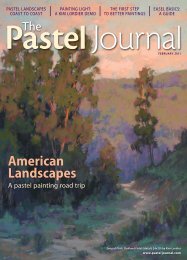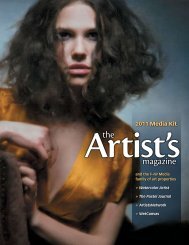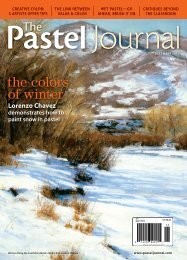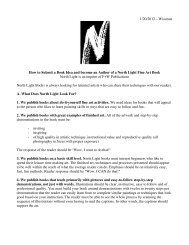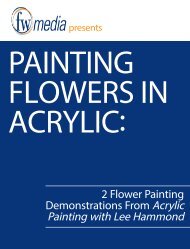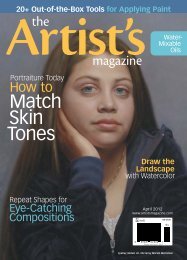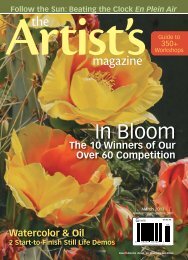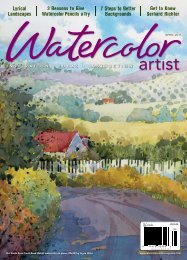Drawing Basics The Landscape And Figure - Artist's Network
Drawing Basics The Landscape And Figure - Artist's Network
Drawing Basics The Landscape And Figure - Artist's Network
Create successful ePaper yourself
Turn your PDF publications into a flip-book with our unique Google optimized e-Paper software.
Special Section ■ <strong>Drawing</strong> <strong>Basics</strong><strong>The</strong> <strong>Landscape</strong> and <strong>Figure</strong>:Draw NowIf you think you can get away withoutlearning to draw, think again. It’s nottoo late and it’s not too hard, when webring two master artists (and theirworkshop exercises) to you.By Maureen BloomfieldPhoto by Caroline Rockey.A classical approachIn the Classical Atelier at the Seattle Academy of Fine Arts,students learn how to draw by copying master drawings,sketching plaster casts and drawing the model from life.48 <strong>The</strong> Artist’s Magazine www.artistsmagazine.com
uliette Aristides and Dale Laitinen, at firstglance, have nothing in common but theirmastery as painters in oil and watercolor. Acloser look at their work, however, revealsthat they’re both astounding draftsmen––afacility earned by years spent drawing everyday. “If I could get my students to draw a milliondrawings before they ever picked up apaintbrush, I’d be happy,” says Laitinen.“<strong>Drawing</strong> is the foundation.”Aristides concurs:“As an artist I feel most confident in that I’vespent more time in drawing than in painting.”Whether you prefer landscapes (like Laitinen)or the figure and still life (like Aristides),whether you work in oil (like Aristides), watercolor(like Laitinen) or any other medium,you’ll benefit from the lessons on drawing theyimpart here.Dale Laitinen<strong>Landscape</strong>s“I live in California, the landscape of superlatives,”says Dale Laitinen. “People and machineshave further developed the surface of theland in extreme ways. I often find my subjectsby looking down from an overlook, a point ofview that allows me to see my subject in abroader context.” A celebrated artist and apopular workshop instructor, he travels with asketchbook that he calls an “idea maker.”Whether at home or on the road, he fills thatsketchbook with value and thumbnail sketches.Starting with a thumbnailA thumbnail sketch isn’t a drawing that you’dconsider, on its own, a work of art. A thumbnailsketch allows you to try out different waysof seeing and drawing—without investing toomuch time or emotion.“<strong>The</strong>se multiple thumbnails are examples ofthe way I look at a subject from various pointsof view,” says Laitinen. “At some point, I coulddevelop one or all of these sketches into paintings(see the examples at right).”Two ways to think about athumbnail sketchTo do a thumbnail sketch, start by dividingyour piece of paper into small rectangles.• <strong>The</strong>n look at your scene in terms of shapes:Find a large shape, then find a medium shapeand a small shape—what the late, famousworkshop teacher Edgar A. Whitney called“Papa Bear, Mama Bear and Baby Bear.”• Try to render the essence—the emotional impact—ofthe scene. Forget about details; thinkdynamics: shape and movement.<strong>Drawing</strong> for itsown sake“I consider Electric Crucifix(graphite and ink, 13x10) adesign that may somedaybecome a painting, butwhether or not it becomesa painting, it’s importantthat I drew it,” says DaleLaitinen. “I tell my students:‘Draw for the love ofdrawing. <strong>Drawing</strong> is a creativeexpression on itsown—not just a means toan end in another mediumor form. To avoid drawingis to miss one of the mostsatisfying activities in art.’”Thumbnail sketchesLaitinen draws in a hardboundsketchbook withblack felt-tip pens andgraphite pencils (2H and2B to 6B). <strong>The</strong>se quick,small sketches show howthe artist sees the landscapeas a system of massand line.June 2004 <strong>The</strong> Artist’s Magazine 49
Special Section ■ <strong>Drawing</strong> <strong>Basics</strong>Seeing in Lines<strong>Drawing</strong> and painting the landscapeSketching a scene is a way to understandit. Note how Dale Laitinen’sdrawings, beautiful in their own right,prepare the way for the subsequentpaintings in watercolor.• <strong>Drawing</strong> lines and sketching values.“It had snowed during the night inYosemite Valley, and a midmorningwalk along the river brought me tothis clump of branches,” says Laitinen.“<strong>The</strong> drawing (A) is both a linedrawing and a value sketch. I workedout the abstract pattern by using bothpencil and pen lines. I then developedthe darks using both graphiteand ink. Choosing a sheet of Archesrough paper, I decided to paint MorningSnow, Merced River (B; watercolor,21x15) in pure, transparent watercolor––workingindoors by referring toboth the sketch and a photographmade on the scene.”AB• <strong>Drawing</strong> a strong diagonal. “<strong>The</strong>midafternoon light cast a rose-red onthe walls of Glen Canyon Dam. I wasintrigued by the shadow of the bridgeand the way it slowly moved acrossthe face of the cliff like a sundial,” hesays. “I used the unusually strong diagonalto connect the bridge and thepowerhouse in both the sketch (C)and Bridge Shadows, Glen Canyon (D;watercolor and gesso, 41x29).D• <strong>Drawing</strong> a thumbnail on the spot.“Leavitt Lake is a place high up theSierra Crest. <strong>The</strong> snowfields made abeautiful, abstract backdrop withstreaks of light on the slice of shoreline,”he says. “I did this thumbnail(F) on the spot. Later, I happenedupon the sketch and developed it intothe painting First Light, Leavitt Lake”(E; watercolor and watercolor/gessooverlays, 15x21).CEF50 <strong>The</strong> Artist’s Magazine www.artistsmagazine.com
Sketching the value pattern firstLaitinen had worked out the pattern oflights and darks at left, so he approachedthe paper with confidence to create Yesterday,Today (below; watercolor, 30x22).Starting with avalue sketchWhile the thumbnailsketch usually dependson shape andline, the value sketchis an exploration of tonal arrangements. Itshows the distribution of the lights and thedarks; it’s a way of organizing your picture.• Use a sketchbook and either a pencil, a stickof charcoal, pen and ink, or gray and blackmarkers. Restrict yourself to four values: light,light midtone, dark midtone and dark.• Show the darkest area, the lightest area (usuallyrepresented by the white of the paper), andthe midtones in between those extremes.• Around your focal point should be the greatestcontrasts of values. <strong>The</strong> way you distributethe midtones should form a pattern that willlead the viewer’s eye through the painting.• Use the value sketch as a road map and a test.If the composition reads in black and white, itwill read in color.<strong>The</strong> “Funny Brush” is like nothing you’ve seen before!<strong>The</strong> famous “Funny Brush” does not conform to thestandard brush you are used to seeing; but you will hardlybelieve the amazing, fast results! Since 1973, seriousartists have been happily creating beautiful trees, foliage,grass and many other subjects. Hard to do textures are abreeze with the “Funny Brush”. It is made to be usedwith oils, acrylics, tempera, watercolors, casein, inks...or just about any media! This revolutionary painting aidbelongs in every artist’s paint box! <strong>The</strong> set of three brushesincludes one each: Regular, Small and Mini foronly $16.00 (including postage). Nevada residents pleaseadd applicable sales tax. Directions included. Check orMoney Order only. SORRY, NO COD’s.Please allow 2-3 weeks deliveryNEW LANDSCAPE VIDEOjay moorePAINTING THE WAY THE EYE SEES“For all the books I have ever read…I havenever had such important knowledgeimported in such a clear and masterful way.”C.P., Montana2 1/2 hours • Four demos • VHS $59.00/DVD $69.00 + S/HPhone orders 303.646.0156Online orders www.appleseedpublishing.comJune 2004 <strong>The</strong> Artist’s Magazine 51
Special Section ■ <strong>Drawing</strong> <strong>Basics</strong>Juliette Aristides<strong>Figure</strong>s“It was understood in earlier centuries that theartist needed to be trained thoroughly as adraftsman before moving on to painting,” saysJuliette Aristides, who has her own atelier,modeled after 19th-century French ateliers, atthe Seattle Academy of Fine Arts. <strong>The</strong> three traditionalways to achieve proficiency as a draftsmanare to copy master drawings, to drawfrom plaster casts of antique statues and tosketch the model from life. Students in Aristides’first-year class draw for at least threehours every day.Copying master drawings<strong>Drawing</strong> is a discipline that teaches you how tosee and how to translate what you see into volumeand line. <strong>The</strong>re’s no better way to get intouch with a master artist’s way of seeing andthinking than to study a drawing and endeavorto reproduce it. Among the many astonishingdraftsmen in the history of art, Rubens (Flemish,1577-1640) has a secure place. <strong>The</strong> figurestudy at bottom was reprinted from one of theartist’s sketchbooks. (Dover has reissued copiesof master artists’ sketchbooks that you maywant to check out.)<strong>The</strong> figure in motionRubens copied drawings andcartoons by Leonardo daVinci (1452-1519) for thesame reason artists copydrawings today––to penetratethe mystery of mastery.Juliette Aristides, payinghomage to that tradition,studied one of Rubens’ drawings(at left) to create herown version (above).DemonstrationLearn to draw the figureby drawing casts“Historically, art students were expected to study idealform and exquisite design before attempting their ownstudy of nature. <strong>The</strong>re was no better place to turn than todraw classical sculptures; there’s no reason not to learnto draw today the same way,” says Juliette Aristides.Once you have a plaster cast, you need to learn how tolight it well and begin as follows.1 21Getting situated. It’s important that you choose acast that you find inspiring. Next, light it with formrevealinglighting (two-thirds light, one-third shadow) soyou have a simple and clear flow of light and strongshapes of shadow. Be sure to set your easel far enoughaway from the cast so that you can easily see it in its entirety.Leonardo da Vinci recommended standing backthree times the height of the object. Place several piecesof newsprint under your drawing paper so it’s wellpadded. Make sure your charcoal is very sharp. Onceyou’ve set up the cast and the lighting, your goal is tocreate the scaffolding or structure for your drawing, as Idid above. Ask yourself repeatedly: Am I making the initialrelationships as accurate as possible?2Getting the proportions. Make a line on the top andbottom to show the limits of the cast and pedestal.Drop a vertical line between them on which you will lateranchor the figure. On the vertical measure, mark thehalfway point and determine the height-to-width relationshipof the cast. This step will give you an accuratelyproportioned armature on which to build your drawing.• Your goal is to simplify the forms so that you’ll establishaccurate relationships. Ask yourself: How can I identifythe gesture of the pose using the fewest number ofangles? What are the dominant angles and how can I repeatthem?• <strong>The</strong> drawing process, in a nutshell, moves from thegeneral to the specific. <strong>The</strong> more you’re able to simplifya complex image into a few, unified lines, the stronger52 <strong>The</strong> Artist’s Magazine www.artistsmagazine.com
your image will be. Avoid focusing on the contour oredge of your cast. Work from the inside to the outside.• Observe how the lines are organized, using a plumbline to determine what forms stack over one another.How do width and height relate to one another?• Imagine that the rib cage and pelvis are boxes. Try topicture how they would be tipped in space.3Adding light and shadow. Your goal in this step isto establish major divisions between the light andthe shadow shapes. Ask yourself: Are the shadow shapesas concise and specific as possible?• When the drawing is as accurate as you can make it byusing just line, you can begin to block in the shadowshapes. In this stage, as you begin to compare shapes,it’s important to squint so that you focus only on largeareas of value.• Focus on the major division between the light and theshadow. This is often called the core shadow; it’s a darkedge located in the halftone areas between the body ofthe light and the body of the shadow.• Imagine your shadow shapes as being a landmass ona map, with the coastline of the shadow shape as an irregularyet very specific contour.GET ACCESSto hundreds of the newestand best art books and videos atwww.NorthLightBookClub.comYou’ll Find…• Selections carefully made by our staffof experts just for you• Special savings of up to 65%• Savings of 15-20% off publishers’ listprices every dayGo to www.NorthLightBookClub.comto join! Members also enjoy…• FREE shipping on prepaid orders• A FREE subscription to North Light magazine• Discounts on <strong>The</strong> Artist’s Magazine andWatercolor Magic subscriptions• <strong>And</strong> much, much more!If you’re already a member of the club, you can nowmanage your membership online! Check it out today!www.NorthLightBookClub.com!3 44Making corrections. Here, your goal is to tone theshadows and reassess the accuracy of gesture andproportion. Ask yourself: Is there any way to make thisdrawing more unified and dynamic before moving on?By now, enough information is established in the drawingto determine how accurate it is compared to the actualcast. Based on the new information revealed by yourlightly blocking in the shadows, you can now make around of smaller drawing corrections. Try looking atshapes rather than just line.When you’ve found and corrected the most obviousdrawing inaccuracies, begin placing your lines and valuesmore confidently by starting to work darker. Keepyour marks uniform and build up the tones gradually soyour drawing will be easy to read and easy to correct.Demonstration continued on the next page.June 2004 <strong>The</strong> Artist’s Magazine 53Easel-ly the BestFor More Info Call TollFree: 877.765.8356 or307.733.6450www.soltekarts.comVersatility? You Get It!You also get: Function, Sturdiness, Ample Storage, Quality,Wind Resistance, Compact, Easy 20 Second Set-up, etc.Now also available intaller “Pro” versionsize:12.5 x 2.6 x 19.75weight: only 9 poundscanvas: max 30” high
Special Section ■ <strong>Drawing</strong> <strong>Basics</strong>5Moving from the general to thespecific. At this stage, the goal isto create volume. <strong>The</strong> question youcan ask yourself is: Am I slowingdown and focusing on one area of thedrawing at a time? <strong>The</strong> beginningstages of the drawing are focused onuniversal characteristics or generaltruths. Now, as you move into thelast stages of the drawing, turn yourattention toward the particulars—those idiosyncratic attributes thatmake an object unique. This step requiresyou to focus on small areas and treat every aspect of thecast with utmost attention.Halftones are responsible for giving your work girth, weightand form. Artists generally work out of the shadows and towardthe light––that’s one way to make sure that each area isfully realized.6Finishing the drawing. Now the goal is to tie up looseends. Ask yourself: Is there anywhere on the drawing wherethe eye stops? How can I link that area to the bigger picture tocreate a more fluid image? Finishing the drawing requires thatyou attend to all the areas that remain unresolved. <strong>The</strong>n focusyour attention on the least successful areas of the drawing.Clean them up one by one.7Learning the lessons. <strong>Drawing</strong> a cast will teach you lessonsthat you can apply to drawing the model from life.That’s the next step in the process: spending two to threehours a day working from life so you can more perfectly learnto see.5 67Ordering OnlineWhere to buy a castVisit www.statue.com (good-quality casts at reasonable prices) orwww.Eleganza.com (casts of excellent quality at a higher price) toorder a cast. Orlandi Statuary also sells casts; the Web site is www.orlandicollections.com.54 <strong>The</strong> Artist’s Magazine www.artistsmagazine.com
Earning our inheritance“<strong>The</strong> human figure has been the most powerfulcarrier of emotion and expression in art,” saysAristides. “In past ages the human form wasseen as the crowning achievement of nature; itwas considered eternal and divine. By paintingand drawing the figure we inherit a wonderful,evocative and supple language capable of conveyingemotion directly to the viewer. Oncewe’ve mastered the fundamentals of drawing,we’re free to focus on content and selfexpressionrather than on more technical concerns.”In other words, learning to draw bydiligently practicing every day will prepare youto make your own contribution to the continuumthat is the history of art.Maureen Bloomfield is senior editor for <strong>The</strong>Artist’s Magazine.From drawing topainting: the enduringmystery“Composition, linear relationships,proportion andvalue––everything otherthan color can be finetunedin the context ofdrawing,” says Aristides.Once she had the preliminariesdown, she was ableto concentrate on the colorin her triptych paintingFlight (oil, 26x58). June 2004 <strong>The</strong> Artist’s Magazine 55



